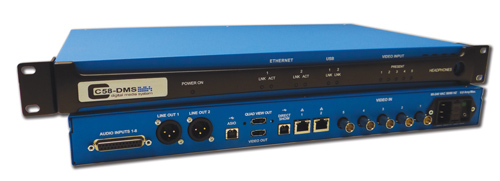PESA will showcase its new C58-DMS streaming media distribution system, as well as its Vidblox fiber/coax extenders and PRO-QV4VP quad view video processor, at Government Video Expo 2012 (Booth 416), which runs November 28-29 at the Walter E. Washington Convention Center in Washington, DC.
Designed for court recording systems, training rooms, security and surveillance facilities, and more, the C58-DMS combines up to eight channels of audio and five channels of video and computer-based content, regardless of format, and delivers synchronized live and on-demand playback.
- “The C58-DMS makes it easy to sync and stream up to five video and eight audio sources in real time or on demand for on-site and off-site viewers,” said Steve Below, global product manager. “It eliminates latency and sync issues, and simplifies playback of mixed format presentations for a variety of government and security applications. Plus, it’s all contained in a 1 RU chassis, which simplifies installation, integration, and cabling issues.”
- H.264 IP camera streams, SDI video up to 720p/60 resolution, and NTSC analog video can be captured simultaneously, plus the C58-DMS can synchronize discrete audio inputs to discrete video and IP video inputs. When it captures and streams multiple HD sources simultaneously, the streams remain associated and synchronized throughout the event. The C58-DMS can simultaneously stream up to six video output streams over IP, including one for each individually selected source and a quad view composed of four sources, and its software makes it easy to record, store, and playback customized presentations.
- PESA’s Vidblox series of independent transmitters and receivers support a common interface between computers and HD video equipment. Available in eight different models to accommodate a variety of applications, Vidblox allows AV professionals to convert, extend, scale, distribute, and transport computer-based content to or from serial digital devices over long distance fiber or coax. The PESA PRO-QV4VP 3G-SDI quad-view video processor automatically detects a variety of video inputs and converts signals to match the native resolution of the display device. Dual outputs (VGA and DVI) allow up to four video signals to be displayed simultaneously on two displays.










